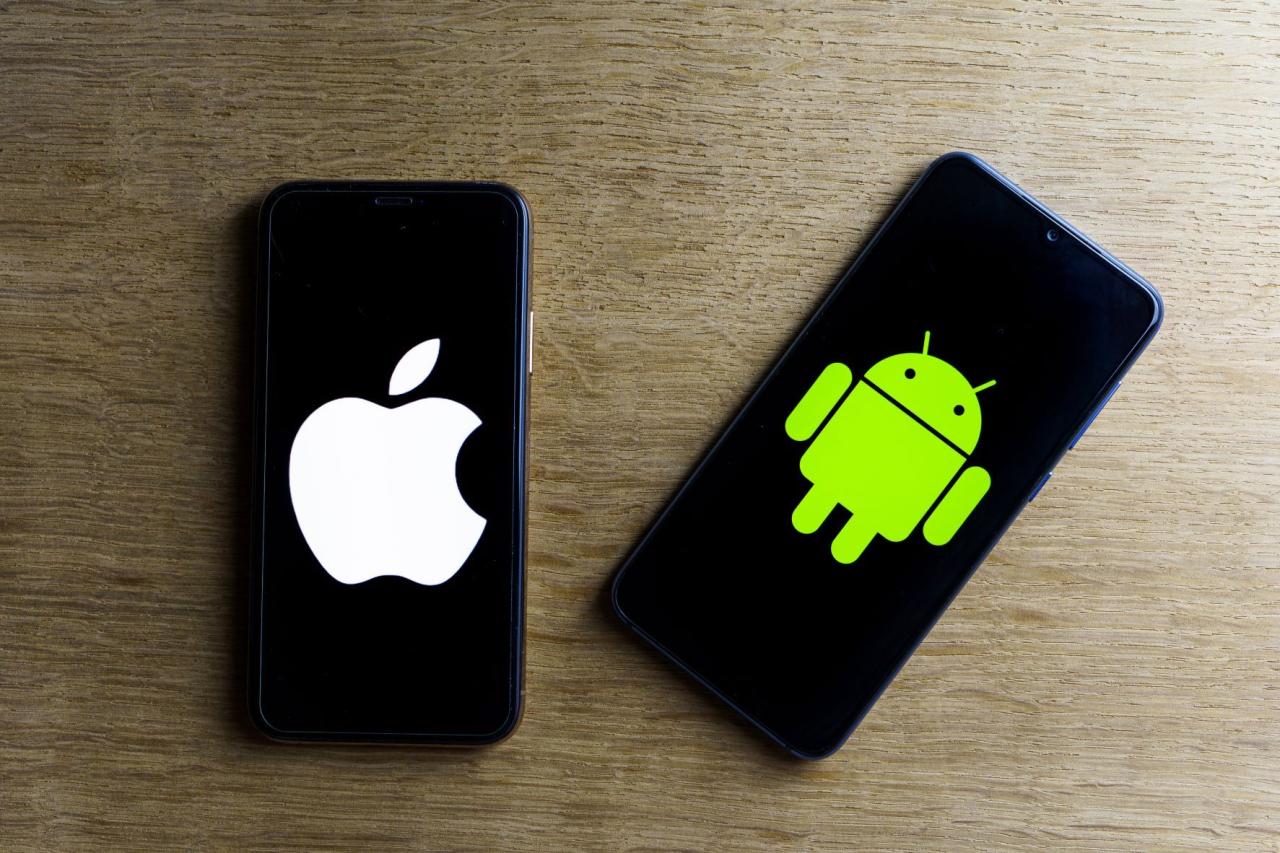Android vs. iOS: The Future of Mobile Innovation. This rivalry, a cornerstone of the mobile landscape, has driven innovation and shaped the way we interact with technology. From their humble beginnings to their current dominance, Android and iOS have revolutionized communication, entertainment, and information access.
The evolution of these platforms, fueled by fierce competition and a constant drive to improve user experience, has led to a dynamic and ever-changing mobile ecosystem. As we delve into this captivating clash of titans, we’ll explore the key factors driving their success, their distinct approaches to user experience, and the impact they have on the development and adoption of mobile applications.
This exploration will cover a wide range of aspects, from the historical development of these platforms to the future trends shaping their evolution. We’ll examine the user interfaces, app ecosystems, hardware integration, security and privacy features, and the exciting possibilities that lie ahead in the realm of mobile innovation.
Find out further about the benefits of Android vs. iOS: Security and Privacy that can provide significant benefits.
The Evolution of Mobile Operating Systems
The mobile landscape has undergone a dramatic transformation, driven by the rise of two dominant operating systems: Android and iOS. These platforms have revolutionized how we communicate, consume information, and interact with the world around us. Understanding their evolution is crucial to grasping the present and predicting the future of mobile innovation.
Early Days and Pioneers
The foundation for modern mobile operating systems was laid in the early 2000s with the emergence of smartphones like the Nokia Communicator and the Palm Pilot. These devices featured rudimentary operating systems that allowed users to perform basic tasks like making calls, sending messages, and accessing limited applications.
- Symbian: Developed by Nokia, Symbian was a dominant force in the early smartphone era. It was known for its flexibility and customizability, allowing for a wide range of third-party applications.
- Palm OS: Developed by Palm Computing, Palm OS was another popular operating system that focused on user-friendliness and ease of use. It introduced features like the Graffiti handwriting recognition system.
- Windows Mobile: Microsoft’s entry into the mobile space, Windows Mobile aimed to leverage the company’s desktop operating system dominance. However, it faced challenges in adapting to the constraints of mobile devices.
The Rise of Android and iOS
The landscape changed significantly with the arrival of Android and iOS. These platforms offered a more sophisticated and user-centric approach to mobile computing.
Do not overlook explore the latest data about Android vs. iOS: Price and Value.
- Android: Launched in 2008 by Google, Android was an open-source operating system designed to be flexible and customizable. It quickly gained popularity due to its wide device compatibility and support from various manufacturers.
- iOS: Apple unveiled iOS in 2007 with the launch of the iPhone. iOS emphasized a closed ecosystem with tight control over hardware and software. This approach resulted in a seamless and intuitive user experience.
Key Factors Contributing to Success
Several factors contributed to the dominance of Android and iOS.
- App Ecosystems: Both platforms fostered vibrant app ecosystems, attracting developers to create innovative applications. This led to a wide range of apps available for users, enhancing the functionality and value of these devices.
- Hardware Integration: Android’s open-source nature allowed for greater hardware diversity, while iOS’s closed ecosystem fostered tight integration between hardware and software. This resulted in optimized performance and a consistent user experience across different devices.
- User Experience: Both platforms prioritized user experience, offering intuitive interfaces, smooth navigation, and features that made mobile devices more accessible and enjoyable to use.
- Marketing and Branding: Android and iOS benefited from strong marketing campaigns and branding strategies that established their presence in the market and cultivated a loyal user base.
User Experience and Interface Design
The user interfaces of Android and iOS are distinct in their design philosophies and navigation methods, shaping the overall user experience. Both platforms have their strengths and weaknesses, appealing to different user preferences.
Check what professionals state about Battery Replacement: DIY vs. Professional Repair and its benefits for the industry.
Android: Openness and Flexibility


Android embraces an open-source approach, allowing for customization and flexibility in its user interface. This openness gives users greater control over their device’s appearance and functionality.
Learn about more about the process of Android vs. iOS: Device Ecosystem in the field.
- Widget Support: Android’s widget system allows users to place interactive elements directly on their home screens, providing quick access to information and frequently used apps.
- Customization Options: Users can personalize their Android devices with different themes, launchers, and icon packs, tailoring the experience to their liking.
- Navigation Bar: Android utilizes a navigation bar at the bottom of the screen, offering back, home, and recent apps buttons for easy navigation.
iOS: Simplicity and Consistency
iOS prioritizes simplicity and consistency in its user interface. It offers a streamlined and intuitive experience, emphasizing ease of use and accessibility.
- Minimalist Design: iOS features a minimalist design with a focus on clean lines, flat icons, and a consistent visual language.
- Gesture-Based Navigation: iOS relies heavily on gestures, such as swiping, tapping, and pinching, to navigate menus, apps, and content.
- Home Button: The home button is a central element in iOS navigation, allowing users to quickly return to the home screen.
App Ecosystems and Development
The app ecosystems of Android and iOS are distinct in terms of app availability, developer tools, and monetization models. These differences influence the user experience and the overall app landscape.
Get the entire information you require about Android vs. iOS: User Interface and Experience on this page.
Android: Open Market and Diversity
Android’s open-source nature allows for a more diverse app ecosystem, with a wider range of applications available through the Google Play Store.
- Large App Selection: The Google Play Store boasts a vast library of apps, catering to a wide range of interests and needs.
- Open Development: Android’s open-source platform allows developers to create and distribute apps without strict limitations, fostering innovation and experimentation.
- Monetization Models: Developers have various options for monetizing their Android apps, including in-app purchases, subscriptions, and advertising.
iOS: Controlled Ecosystem and Quality
iOS maintains a more controlled ecosystem, with a focus on app quality and user experience. The App Store has stricter guidelines for app submission, resulting in a curated selection of apps.
- Curated App Store: The App Store features a curated selection of apps, ensuring a higher level of quality and user experience.
- Strict Guidelines: Apple imposes strict guidelines for app development and submission, aiming to maintain a high standard for apps available on the platform.
- Monetization Model: iOS primarily relies on in-app purchases and subscriptions for app monetization, with a limited role for advertising.
Hardware Integration and Customization
Android and iOS offer different approaches to hardware integration and customization, influencing the user’s ability to modify and enhance their devices.
You also can investigate more thoroughly about How to Choose a Phone with the Right Battery for You to enhance your awareness in the field of How to Choose a Phone with the Right Battery for You.
Android: Openness and Flexibility
Android’s open-source nature allows for greater hardware diversity and customization potential. Users can choose from a wide range of devices and customize their software experience to their liking.
- Wide Device Compatibility: Android runs on a diverse range of devices from different manufacturers, offering users a wide selection of hardware options.
- Open-Source Software: Android’s open-source nature allows developers to modify and customize the operating system, leading to a wealth of custom ROMs and modifications.
- Customization Options: Users can personalize their Android devices with custom launchers, themes, and widgets, tailoring the experience to their preferences.
iOS: Closed Ecosystem and Consistency
iOS operates within a closed ecosystem, with tight control over hardware and software. This approach ensures a consistent and optimized user experience across all iOS devices.
You also can investigate more thoroughly about The Environmental Impact of Smartphone Batteries to enhance your awareness in the field of The Environmental Impact of Smartphone Batteries.
- Limited Device Selection: iOS runs primarily on Apple devices, offering a limited selection of hardware options compared to Android.
- Closed Ecosystem: Apple tightly controls the iOS ecosystem, limiting customization and modifications to the operating system.
- Seamless Integration: iOS’s closed ecosystem ensures seamless integration between hardware and software, resulting in a consistent and optimized user experience.
Security and Privacy Considerations
Security and privacy are paramount concerns in the mobile landscape. Both Android and iOS have implemented features to protect user data and safeguard devices from threats. However, the open-source nature of Android and the closed ecosystem of iOS present different challenges and considerations.
Android: Openness and Vulnerability, Android vs. iOS: The Future of Mobile Innovation
Android’s open-source nature allows for greater customization and flexibility, but it also creates vulnerabilities that can be exploited by malicious actors.
- Vulnerability to Malware: Android’s open ecosystem makes it more susceptible to malware attacks, as malicious apps can be distributed through unofficial app stores.
- Data Protection Concerns: Android’s open-source nature can pose challenges in ensuring data privacy, as user information may be accessed by third-party apps.
- Security Updates: Android’s fragmented ecosystem can delay the delivery of security updates to devices, leaving them vulnerable to exploits.
iOS: Closed Ecosystem and Security
iOS’s closed ecosystem offers a more secure environment, with tighter control over app development and distribution.
- Strong Security Measures: Apple implements strict security measures to protect user data and devices from malware and other threats.
- Limited App Access: iOS’s closed ecosystem restricts app access to user data, minimizing the risk of data breaches and privacy violations.
- Regular Security Updates: Apple releases regular security updates to iOS devices, ensuring that users have the latest security patches and protections.
Emerging Trends and Future Directions
The mobile landscape is constantly evolving, driven by emerging trends like artificial intelligence, augmented reality, and 5G connectivity. These advancements will shape the future of mobile innovation and influence the development of Android and iOS.
Artificial Intelligence and Machine Learning
AI and ML are transforming mobile devices, enabling more personalized experiences, intelligent assistants, and enhanced security features. Both Android and iOS are integrating AI into their platforms, offering features like voice assistants, smart recommendations, and predictive text.
In this topic, you find that Android vs. iOS: Customization Options is very useful.
Augmented Reality and Virtual Reality
AR and VR technologies are creating immersive experiences that blur the lines between the physical and digital worlds. Mobile devices are becoming platforms for AR and VR applications, offering new possibilities for entertainment, education, and commerce.
5G Connectivity
5G networks are ushering in a new era of mobile connectivity, enabling faster speeds, lower latency, and greater bandwidth. This will unlock new possibilities for mobile applications and services, driving innovation in areas like cloud gaming, streaming, and IoT.
Find out further about the benefits of The Role of Software in Battery Optimization that can provide significant benefits.
The Rise of Foldable Devices
Foldable devices are challenging the traditional smartphone form factor, offering larger screens and more versatile usage scenarios. Both Android and iOS are adapting to this new form factor, developing software experiences that optimize for foldable displays.
Potential for New Mobile Operating Systems
While Android and iOS currently dominate the mobile landscape, there is always potential for new mobile operating systems to emerge and challenge the status quo. Factors like open-source development, innovative features, and strong marketing campaigns could contribute to the rise of new platforms.
Final Thoughts: Android Vs. IOS: The Future Of Mobile Innovation
In the ever-evolving world of mobile technology, Android and iOS continue to push boundaries and shape the future. The ongoing competition between these two giants ensures a dynamic landscape where innovation flourishes and users benefit from a constant stream of improvements.
Obtain a comprehensive document about the application of Battery Life and the Aging Process of Smartphones that is effective.
As we look ahead, the integration of emerging technologies like artificial intelligence, augmented reality, and 5G connectivity promises to further revolutionize the mobile experience. The future of mobile innovation is bright, and the battle between Android and iOS is likely to remain a captivating force, driving the development of even more powerful and intuitive mobile devices and applications.
Clarifying Questions
What are the main differences between Android and iOS?
Android is an open-source operating system known for its flexibility and customization options, while iOS is a closed-source platform that prioritizes user experience and security.
Which platform is better for gaming?
Both platforms offer excellent gaming experiences, but iOS often has a slight edge in terms of graphics performance and exclusive titles.
Is Android or iOS more secure?
Both platforms have their strengths and weaknesses in terms of security. iOS is generally considered more secure due to its closed ecosystem, but Android offers more control over security settings.
Which platform is more user-friendly?
iOS is known for its intuitive user interface and simplicity, while Android offers greater customization options and flexibility.
What is the future of mobile operating systems?
The future of mobile operating systems is likely to be characterized by advancements in artificial intelligence, augmented reality, and 5G connectivity, leading to even more powerful and immersive mobile experiences.









